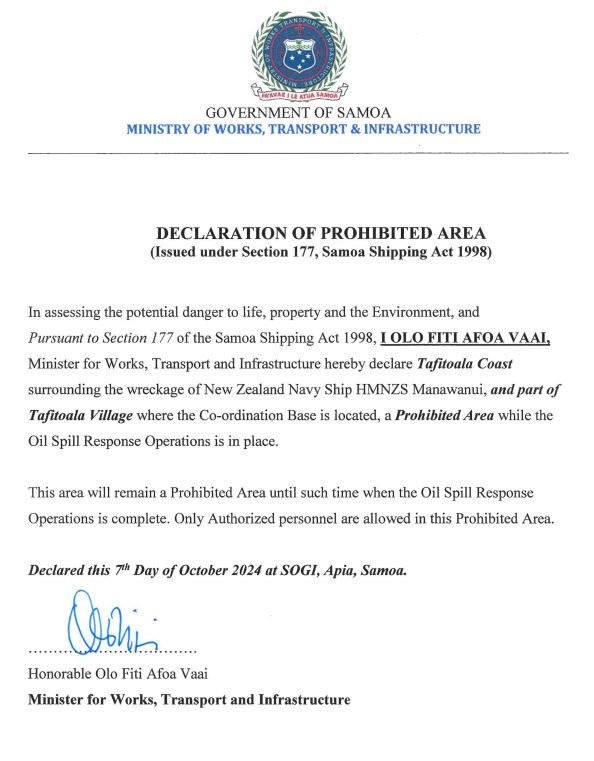
Apia, Samoa—8 October 2024
Samoa is confronting a potential environmental disaster after the HMNZS Manawanui, a New Zealand Navy vessel, ran aground and sank off the southern coast of Upolu on 5 October 2024. The shipwreck, now resting off the coast, poses a serious threat to the marine ecosystem due to the potential for a fuel leak. Both the Samoan and New Zealand governments are working together to minimise the environmental impact and prevent a full-scale oil spill.
The Incident
The HMNZS Manawanui, a dive, salvage, and hydrographic survey vessel, was conducting a routine seabed survey when it struck a reef near the Taftioala Coast. Following the collision, the vessel caught fire and sank the next morning. Fortunately, all 75 crew members were safely rescued by local emergency services, but the shipwreck has raised environmental alarms.
The New Zealand Defence Force and Samoa’s authorities have coordinated their response to prevent any environmental damage, but concerns remain about the risk of fuel leaking from the vessel’s tanks, which could harm the nearby marine environment, including coral reefs and marine life.
Government Response
On 7 October 2024, Olo Fiti Afou Vaai, Samoa’s Minister for Works, Transport, and Infrastructure, declared a prohibited zone around the wreck site, including the Taftioala Coast and parts of Taftioala Village. This area will remain restricted to the public while oil spill response teams work on containing and managing the potential spill. Only authorised personnel are permitted within the designated area.

Environmental Concerns
The potential for an oil spill has raised significant concerns for the coastal and marine ecosystems in Samoa. Local residents have reported detecting a strong odour of oil near the coast, and there have been some early signs of oil leaking into the water. This poses a direct threat to the coral reefs and sea turtle populations that inhabit the area, both of which are vital to the local environment and economy.
Samoa’s coral reefs are a critical part of its ecosystem, offering protection to coastlines and supporting a wide range of marine species. If oil contamination were to reach these reefs, it could result in long-term ecological damage, smothering corals and disrupting marine life. Local populations of green sea turtles, which are a significant attraction for tourists, are also at risk of exposure to harmful hydrocarbons, potentially affecting their health and breeding grounds.
The Acting Prime Minister of Samoa, Tuala Tevaga Iosefo Ponifasio, issued a statement on 8 October, confirming that while small leaks of oil had been identified, no major spillage had yet affected the reefs or shores. Specialised equipment has been deployed to manage the leaks, and marine scientists are conducting ongoing tests of water and sediment samples to monitor the situation. Local authorities have assured the public that all necessary measures are being taken to prevent further environmental damage.

New Zealand's Assistance
New Zealand has responded swiftly to the incident, deploying specialist divers and sending oil spill containment kits to the site. Judith Collins, New Zealand's Defence Minister, emphasised the priority of environmental protection, noting that the Manawanui carried a significant amount of fuel that could pose a serious risk if further leaks occurred. Collins also announced that a Court of Inquiry would be convened to investigate the cause of the incident.
The collaboration between New Zealand and Samoa has been key to addressing the environmental risks posed by the shipwreck. A combined force of divers, environmental experts, and spill response teams has been working continuously to mitigate the damage and prevent a wider spill from occurring.
Local Impact
The potential damage extends beyond environmental concerns. The fishing industry in the area, which is a crucial source of food and income for local communities, could be severely impacted by an oil spill. The coastal waters around Upolu also serve as an important tourist destination, particularly for snorkelling and diving. Any long-term environmental damage could significantly affect the local economy by reducing fish stocks and deterring tourists from visiting the region.
Samoa’s government has urged the public to stay clear of the prohibited areas and report any sightings of oil or other pollutants. Marine scientists will continue monitoring the situation, with full environmental assessments expected to take place in the coming days.
What Lies Ahead
While the immediate risk of widespread oil pollution has been mitigated, the long-term environmental impact remains uncertain. Experts are continuing to assess the damage to coral reefs and marine ecosystems. Ongoing recovery efforts will focus on removing any oil that leaks from the wreck and ensuring the affected areas can recover as quickly as possible. The cooperation between Samoa and New Zealand is critical to containing the crisis, and further updates are expected as clean-up efforts progress.
In the meantime, both governments are urging caution and patience as the situation develops, with the hope that swift action can prevent further damage to Samoa’s fragile coastal environment.
Summary
The sinking of the HMNZS Manawanui has placed a heavy burden on both the Samoan and New Zealand governments to act swiftly in preventing an environmental catastrophe. While human lives were saved, the future of Samoa’s marine ecosystems, including its coral reefs and turtle populations, now hinges on successful mitigation and recovery efforts. The situation remains fluid, with both governments working around the clock to address the immediate risks while planning for long-term environmental recovery.



Comments